Plenary Programme - Thursday 2 May
Osseointegration was discovered 50 years ago and the first patient was treated in 1965. After a considerably active academic debate, osseointegration was finally accepted as a reliable concept for treating patients with oral implants around 1980. Since then indications have widened and clinical results gradually improved, particularly after the introduction of new, moderately rough surfaces some 10-15 years ago. In a recent overview, the first 9 clinical papers of such new implants, followed up for 10 years or more, verified CSR rates of 95% or more with ongoing problems of peri-implantitis limited to 0.88% of about 1.800 implants. However, as agreed at a recent consensus meeting in 2012, the precise magnitude of problematic implants with bone resorption may vary depending on the type of implant, clinical skills of the doctor and status of the patient. For example, patients who are smoking and suffering from compromised bone beds may, particularly if treated by poorly trained clinicians, end up in much greater magnitude of problems in form of implant failure or peri-implantitis than figures quoted above.
Learning Objectives
- To set the scene for the whole congress
- To give a brief history of the journey of osseointegration from the early days of discovery to the current state of development with special reference to implant geometry, design and surfaces
- To discuss briefly the main challenges facing implant dentistry and what future developments might bring
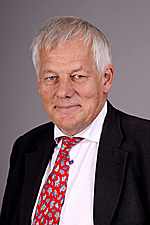
Professor Albrektsson has been the Professor and Head of the Department of Biomaterials, University of Gothenburg, since 1986, and has been the Chairman of that Department since 1988, which today is part of the Department of Clinical Sciences, Sahlgren´s Academy, University of Gothenburg, Sweden. He has been a board member of the Department of Surgical Sciences for more than 10 years and of the Department of Clinical Sciences since 2006. Professor Albrektsson is the close co-worker of P I Brånemark in the development of osseointegrated oral and craniofacial clinical treatment, which had an international breakthrough in 1982 and 1992. He is a senior member of the team that developed new osseointegrated hip arthroplasties for clinical usage in 2005. He is the editor of 10 scientific books and the member of the Editorial Board of eight international, scientific journals. He is the Editor-in-Chief of Applied Osseointegration Research, a scientific monograph, since 2000. Professor Albrektsson has written approximately 650 abstracts, reviews and scientific papers on bone grafts, vital microscopy of bone, experimental implants, oral and craniofacial reconstructions and orthopaedic implants.
The Paper by Brånemark, Albrektsson et al (1983) was in 2006 awarded one of the top papers published in Biomaterials over 25 years. The Paper by Wennerberg & Albrektsson (2000) was awarded title of best paper in Int J Oral & Maxillofacial Implants published in 2000.
Professor Albrektsson is ranked among the six most quoted scientists of the Medical faculty of the University of Gothernburg in an investigation covering the years between 1986 and 2001. In 2011 Professor Albrektsson became an Honorary member of the British Society for Specialist prosthodontic disciplines, BSSPD, and he was in 2012 the recipient of the American Prosthodontic Society Gold Medal Medallion Award. He has presented over 1,000 lectures to professional audiences all over the world.
Tooth extraction without concomitant bone grafting results in osseous deformities of the alveolar ridge, such as reduced height and width. This makes subsequent management of aesthetics, prosthetics and implant placement very challenging. Socket grafting using regenerative bone materials has been shown to significantly reduce bone loss, maintain ridge dimensions and enhance the clinician’s ability to provide aesthetically and functionally satisfying restorations.
The aims and objectives of this lecture will be to discuss the biological risk factors that may influence the aesthetic, prosthetic and surgical success and delivery of implant treatment with special emphasis to site development and augmentation.
Learning Objectives
- To discuss the effect of local and systemic factors including the patient’s immunological state, drug history (incl. plaque & biofilm) on treatment planning and success of implant treatment aesthetically, restoratively and surgically
- To discuss the importance of site development and ridge preservation in influencing the aesthetic, surgical and restorative outcome of implant treatment
- To discuss the steps of extraction socket grafting and ridge preservation
- To present the instrumentation for successful surgical bone augmentation
- To discuss the selection of appropriate bone graft materials and biological enhancements
- To offer practical advice on socket augmentation and ridge preservation
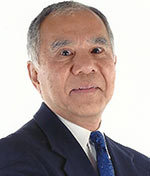
Professor Suzuki is Professor of Microbiology and Immunology (School of Medicine) and Professor of Periodontology and Oral Implantology (School of Dentistry) at Temple University, Philadelphia, USA. He also serves as the Chairman and Director of Periodontology and Oral Implantology at Temple University. Professor Suzuki has served as Dean of the University of Pittsburgh, USA and immediate past Chairman of the Food and Drug Administration Dental Products Panel. He received his DDS from Loyola University of Chicago and a PhD in Microbiology from the Illinois Institute of Technology. He completed an NIH Fellowship in Immunology at the University of Washington in Seattle, and a Clinical Certificate in Periodontics at the University of Maryland.
Diagnostic imaging is an essential part of the treatment planning process in implant dentistry. This presentation will explore the benefits, opportunities and risks that may stem from the radiological investigation.
Although 2D and medical CT imaging still have a useful role to play, the introduction of CBCT has irreversibly and dramatically changed the process of treatment planning, implant planning, implant surgery, and prosthetic reconstruction. Access to 3D imaging technologies enhances the operator's ‘3D-thinking’ and 3D perception and opens up a wealth of possibilities, including the use of angled or short implants to overcome anatomical limitations.
An informed understanding of the strengths and weaknesses of available imaging modalities, and the sensible use of available guidelines and optimisation strategies, will enhance the benefit to the patient, surgeon, and prosthodontist, whilst reducing the inherent risks of both the diagnostic and the implant procedure.
The ability to export CBCT data to planning software or for use in CAD CAM systems has revolutionised implant dentistry. Rapid technological advances in imaging have been accompanied by synergistic advances in computer aided design and in 3D printing and manufacturing technologies. All of this combines to improve diagnosis, facilitate and expedite treatment, and link the surgical plan to the planned prosthetic result, transforming the reconstructive process.
Learning Objectives
- To review ADI guidelines on diagnostic imaging
- To give a critical review of different diagnostic imaging techniques used in implant dentistry including their advantages and disadvantages and diagnostic capabilities
- To briefly outline the risk of ionising radiation, the risk/benefit ratio and ALARA principle, and to explain how the concepts of optimisation and justification may be applied to implant dentistry
- To briefly discuss 3D treatment planning and computer-assisted implant-placement techniques and how to utilise these techniques to improve treatment and minimise risks and complications
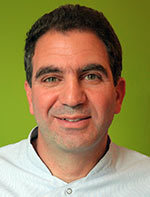
Dr Dawood qualified from The Royal London Hospital in 1984. After hospital appointments at Guy’s Hospital, University College Hospital, The Eastman Hospital, and The Hospital for Sick Children, Great Ormond Street, he went on to study for a Master's degree in Conservation at Guy’s Hospital. In 2000, Andrew was accepted on to the Specialist Registers in both Prosthodontics and Periodontics.
Andrew has been placing implants for more than 20 years. He lectures extensively in the UK and abroad, and devotes time to Research and Development in Implant Dentistry, 3D Imaging, and 3D Manufacturing; several of his innovations have been patented. He has honorary appointments at University College, St Bartholomew’s, and The Royal London Hospitals, where he is involved in advanced implant treatments for patients requiring facial reconstruction.
Before implant dentistry was available, significantly more effort was placed on preserving compromised but well maintained teeth. Today, the increased confidence in osseointegration has influenced the decision to extract periodontally affected teeth, which in several cases may be treatable using conventional or regenerative periodontal therapies. The extraction of a periodontally compromised tooth and its replacement with a dental implant, as opposed to retention of this tooth, is today one of the most debatable decisions that a dentist has to take.
The treatment choice cannot be guided solely by the scientific evidence on the efficacy of these two treatment principles but should take under consideration personal clinical experience, access for technology and education as well as patient preferences, and economic parameters.
This presentation will discuss the relative success of keeping periodontally compromised but well maintained teeth versus placing implants in periodontally compromised patients. It will critically appraise the available literature on long-term survival and success rates, patient based outcomes and economic parameters of implant and teeth supported restorations in periodontal patients as well as the risk for complications in both cases. A combined patient and site risk profile assessment developed by our team will be presented which together with a cost–benefit analysis based on each individual patients expectations would be able to offer clinical advice on when to extract and replace with implants and when to retained compromised teeth.
Learning Objectives
- To review the evidence on the prognosis and success of keeping periodontally compromised but well treated teeth
- To review the evidence on prognosis/success of implant treatment in patients with history of periodontal disease
- To offer practical and clinical advice on when to extract and replace with implants and when to retained compromised teeth
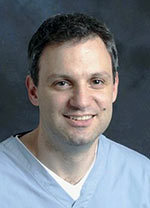
Dr Mardas qualified in Dentistry from University of Athens, Greece in 1992 and he completed his three-year specialist training and the Master of Science degree in Periodontology at the Royal Dental College, University of Aarhus, Denmark in 1997. He was awarded his PhD in 2005 from the same University. In 2005, he joined the world known Eastman Dental Institute (UCL) where he is currently Senior Clinical Lecturer and co-ordinator for the MClin Dent in Periodontology program.
Dr Mardas is a member in all the leading National and European scientific and professional bodies in periodontology and implant dentistry and is a Fellow of the International Team for Implantology. He has published many papers in national and international journals in the field of tissue regeneration and dental implants and in 2011 he was awarded the basic research price from the European Association of Osseointegration.
He is an editorial board member in national and international scientific journals and he has extensively lectured around the world. Dr Mardas has more than 16 years of private practice and university/hospital-based post-qualification clinical experience in periodontics and implant dentistry in Denmark, Greece and UK where he is currently consultant Periodontist and implant surgeon in three private practices.
Peri-implant disease is a contentious topic within implant dentistry. At the Focus on Peri-implantitis meeting in 2010 the ADI explored the aetiology of peri-implantitis. Following on from this meeting, in November 2012 an expert panel formed to reach a consensus on how to identify and treat peri-implant disease at each stage in the process. The lecture will present the findings from the ‘ADI Expert Panel Consensus Meeting on Monitoring, Diagnosis and Treatment of Peri-implant Disease’.
Learning Objectives
- To report on the ADI guidelines for monitoring, diagnosis and treatment of peri-implant disease
- To examine how to treat the complications of peri-implant disease
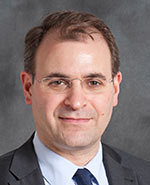
Professor Donos is the Head & Chair of Periodontology and the Director of Clinical Research at the UCL - Eastman Dental Institute, London and the Lead of the Oral Health Theme at the UCLH/UCL Comprehensive Biomedical Centre. Professor Donos leads the Clinical Investigation Center at the Eastman which specializes in the provision of RCT and clinically applicable translational research studies. His research track record is mainly on GTR, GBR, implant dentistry as well as in the correlation of periodontal disease with other chronic diseases. He has published extensively and he is member of the editorial board of the leading peer-reviewed journals.
This lecture addresses common implant complications, specifically biologic aspects and the approaches to avoid these problems before they occur. Classification and diagnosis of these complications will be illustrated. The common aetiologies that contributed to this problem such as implant positioning and timing of implant placement, biomechanical stress, plaque and residual cement will also be addressed. In addition, a decision tree of how to manage these complications will also be presented. The pros and cons of techniques used to treat implant diseases/complications such as chemotherapeutic agents, apically positioned flap, implant surface detoxification, guided bone regeneration, soft tissue grafts, implant removal as well as re-implantation will be discussed.
Learning Objectives
- To recognise aetiologic factors that contribute to biological implant complications, understand decision tree used to select treatment modalities for the management of implant complications and learn how to properly manage peri-implantitis.
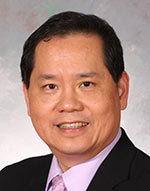
Dr Wang is Collegiate Professor of Periodontics and Professor and Director of Graduate Periodontics at the University of Michigan. Dr Wang received his DDS from Taipei Medical College, Taipei, Taiwan; DDS, MSD from Case Western Reserve University, Cleveland, Ohio; and PhD from Hiroshima University, Japan. He also serves as a Research advisor for Eng. A.B. Research Chair for Growth Factors and Bone Regeneration, King Saud University Riyadh, Saudi Arabia.
He has published more than 22 book chapters/invited reviews and more than 250 scientific articles. Dr Wang serves as a Chair of Website Educational Committee for the Academy of Osseointegration, is a Diplomate and a Former Co-Chair and Director of the American Board of Periodontology and is the Diplomate and Former President and Board Director of the ICOI and a Fellow of American College of Dentists.
He was a former President of the Midwest Society of Periodontology, a former Consultant for the ADA Commission on Dental Accreditation, and a past Editor-in-Chief for the Open Dentistry Journal. He serves as an Associate Editor for The International Journal of Oral & Maxillofacial Implants, eJournal of Oral & Maxillofacial Research, and International Chinese Journal of Dentistry, and is Founding Editorial board member for newly introduced Clinical Advances in Periodontics Editorial Board member for the Journal of Periodontology, Clinical Oral Implants Research, International Journal of Periodontics & Restorative Dentistry, Journal of Clinical Periodontolog, Compendium of Continuing Education in Dentistry and many others.
Dr Wang is the recipient of the following awards/honours: AADS clinical research fellowship award (1992), Best Faculty Award (2003), The Charles E. English Annual Award in Clinical Science and Techniques (2004), Best papers in Journal of Oral Implantology (2004) and Implant Dentistry (2004), Morton L. Perel Annual Award for Dental Implant Educator (2007), and AAP University of Michigan Outstanding Teaching and Mentoring in Periodontics (2010).
The aim of this presentation is to discuss biological complications related to buccal bone loss and soft tissue recession following implant placement.
Learning Objectives
- To assess the prevalence and extent of midfacial peri-implant mucosal recession and of inadequate development of the interproximal papillae
- To evaluate the factors affecting the alveolar process remodelling and peri-implant soft tissue changes following implant placement
- To discuss the effectiveness of techniques recommended for correction/augmentation of peri-implant soft tissue defects
- To give expert practical advice/tips to the audience
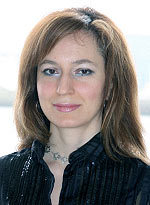
Dr Retzepi is a registered specialist in Periodontics and honorary Clinical Lecturer in Periodontology at the UCL Eastman Dental Institute. She is the recipient of the most prestigious international awards in Dental Implantology, namely the 2009 European Association of Osseointegration Research Award and the 2010 Andre Schroeder Research Prize for her research on the effect of diabetes mellitus on osseointegration and on Guided Bone Regeneration.
Dr Retzepi graduated as a Dental Surgeon from the University of Athens Dental School, where she also obtained her Master of Science degree in Oral Biology and Certificate of Clinical Specialisation in Periodontics with distinction. She then completed a clinical fellowship at the Department of Periodontology and Fixed Prosthodontics, University of Berne, Switzerland. Dr Retzepi has received her Doctor of Philosophy (PhD) degree in Clinical Dentistry from the UCL Eastman Dental Institute and she is a Fellow of the Higher Education Academy. She currently works in specialist private practice in Central London.
Aesthetically replacing missing teeth in areas of significant anterior ridge deformities has been and still is a significant challenge in dentistry. High aesthetic expectations and the addition of implant therapy have only increased the challenge. It is, therefore, necessary for clinicians and technicians to fully understand all the available options and limitations as well as where, when, and how to best utilise them. This lecture will outline a new prosthetic option beside the existing, surgical and orthodontic options to enhance aesthetically the deficient anterior ridge. Emphasis will be placed on the analysis, design, benefits and manufacturing of the 3-dimensional prosthetic reconstruction of deficient ridges and its ability to enhance the aesthetic result of the final tooth form (White Aesthetics) and gingival design (Pink Aesthetics) as well as lip support. A detailed decision-making protocol will be suggested to help guide clinicians and technicians toward creating the most successful aesthetic and functional outcome for their patients.
Learning Objectives
- To evaluate the limitations when restoring a deficient ridges - the decision-making process
- To understand the importance of ideal soft tissue architecture for developing natural looking restorations - the white and pink interface
- To look at when and how to utilise artificial gingiva
- To look at clinical and laboratorial procedures when fabricating the pink hybrid restoration
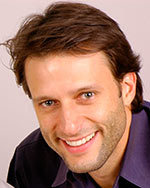
Dr Coachman graduated in Dental Technology in 1995 and in Dentistry at the University of São Paulo/Brazil in 2002. He is a member of the Brazilian Academy and Society of Esthetic Dentistry. Moreover, Dr Coachman attended the Ceramic Specialization Program instructed by Dr Dario Adolfi at the Ceramoart Training Centre, where he also became an instructor. In 2004, Dr Coachman was invited by Dr Goldstein, Garber, and Salama, of Team Atlanta, to become Head Ceramist of their laboratory, a position he held for over four years. He has been working with many leading dentists around the world such as Dr Van Dooren (Belgium), Gurel (Turkey), Fradeani (Italy), Bichacho (Israel) and Calamita (Brazil). Dr Coachman currently works as a consultant for dental offices and companies developing products and implementing concepts and has lectured and published internationally in the fields of esthetic dentistry, dental photography, oral rehabilitation, dental ceramics and implants.
Over the past twelve years litigation against UK dentists has grown exponentially. Dentist are understandably angry and concerned when they are subject to a claim This session will look at what factors cause a claim to be settled and why claimant lawyers have been so successful in the dental market. The session will go on to explore what steps a practitioner can take to reduce the chances of a successful claim. The key areas are making sure the correct diagnosis has been made, the treatment has been properly planned and valid consent obtained. The outcome of untoward or unexpected consequences of treatment will be discussed and the difference between an adverse outcome and “just one of those things” will be discussed. The importance of candour when untoward consequences happen will be explained and above all the importance of accurate contemporaneous records will be stressed.
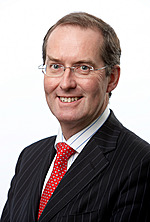
Dr Henderson is a Senior Dento-legal advisor for Dental Protection Ltd based in the London office. He has worked for DPL since 2000. Stephen is a Specialist in Oral Surgery and his background was firstly in hospital practice working in a number of oral surgery units before moving to Oxford where he has been in mixed general and referral practice for more than twenty years. He continues to work in practice on a part time basis.
Within DPL Dr Henderson's particular interest, following his degree in Medical Law, is Regulatory Law and he reports to the team on the activities of the GDC and CHRE. He is also DPL’s Deputy Lead for Hong Kong.
